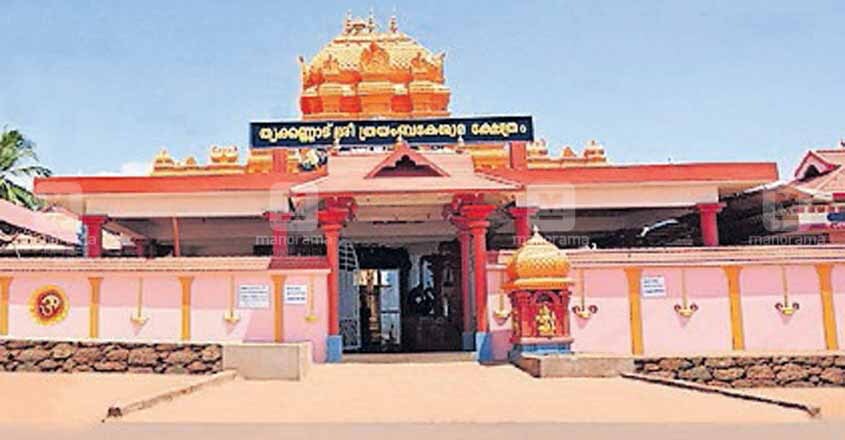They are Located in Sati's Body Parts
In Hindu mythology, the son of Brahma, King Prajapati Daksha had a daughter named Sati.
Princess Sati grew up adoring the legends and tales of Shiva, and when finally her age of getting married came, she knew it was only the ascetic Lord Shiva of Kailash where her heart and soul resided.
Soon enough, Daksha’s daughter left her father’s luxuries and palace and began her meditation to win Shiva’s heart.She performed intense penance in dense forests and renounced food completely. When she finally pleased Shiva through her austerities, the lord of Kailash appeared in front of her and agreed to marry her.
The legend goes that Sati and Shiva were happy in their marital bliss, but their marriage had not gone down too well with King Daksha, who considered ascetic Shiva nothing short of an uncouth lad who lives a hermit’s life not worthy of his daughter.
So when Daksha organized a great yajna, he invited all the deities, gods and sages–but consciously excluded his son-in-law Shiva to insult him. Hurt by her father’s decision, Sati decided to visit her father and demand the reason for not inviting them. When she entered Daksha’s palace, she was bombarded with insults directed towards Shiva.
Haughty and proud King Prajapati Daksha called him all sorts of names right from a dishevelled god who hung out in a graveyard to the supposed ‘lord of the beasts’. Unable to bear anything against her husband, a devastated Goddess Sati threw herself in the glowing sacred fire of yajna.
When Shiva’s attendants informed him about the demise of his wife, he grew enraged and created Veerbhadra from a lock of his hair. Veerbhadra created havoc in Daksha’s palace and killed him.
Meanwhile, mourning his beloved soulmate’s death, Shiva tenderly held Sati’s body and started his dance of destruction (taandav). To save the universe and bring back Shiva’s sanity, Lord Vishnu cut Sati’s lifeless body using Sudharshan Chakra into 51 pieces.
These pieces fell on earth at various places and came to be known as Shakti Peeths. All these 51 places are considered to be holy lands and pilgrimages.
1. Amarnath: Shakti Mayamaya, Body part–Throat

One of the most famous temples of India, the Amarnath Shakti Peeth is located in India’s Jammu & Kashmir. Situated near Pahalgam in Anantnag district, this temple opens for pilgrimages during July/August when the Shivling is available for darshan. The throat of Goddess Sati is said to have fallen here. The devi resides here in the form of Shakti Mahamaya with Trisandhyeshwar as Vairabh.
2. Attahasa : Shakti Phullara, Body part–Lips
This Peeth is located in Attahasa Village of Labhpur in Birbhum district of West Bengal. The goddess appears as Shakti Phullara and her lower lip is said to have fallen here. It is compulsory to offer sour eatables whenever bhog is offered to the Shakti.
3. Bahula: Shakti Bahula, Body part–Left Arm

Located on the banks of Ajay River, this holy land is situated in Ketugram, roughly eight kms from Katwa of Bardhaman district in West Bengal. The goddess resides here in the form of Devi Bahula and is accompanied by Bhiruk as the Bhairava. The left hand of Sati fell on this land.
4. Bakreshwar : Shakti Mahishmardini, Body part–Centre portion between eyebrows
This Peeth is located on the banks of Paaphara River, approximately 24 kms south west of Siuri town. The centre portion of Goddess Sati had fallen here and she is worshipped in the form of Shakti Mahishamardini The temple is renowned for its eight natural hot springs which are enriched with healing powers.
5. Bhairav Parvat: Shakti Avanti, Body part–Elbow
Maa Sati resides here in the form of Goddess Avanti. This peeth is located near Ujjain in Madhya Pradesh at the Bhairav hills on the banks of Shipra River. In this temple, the goddess’s upper lip had fallen.
6. Bhawanipur: Shakti Aparna, Body part–Left anklet
Goddess Sati appears as Devi Aparna with Vaman as Lord Shiva in the Bhawanipur peeth, located in the Sherpur Village of Bangladesh. Here, the left anklet (ornament) of Sati had fallen.
7. Gandaki: Shakti: Gandaki Chandi, Body part–Forehead
Near the bank of Gandaki river, lies the Muktinath, Dawalagiri Peeth in Nepal. Maa Sati resides here in the Gandaki Chandi form with Chakrapani as the Bhairav. Here, her forehead had fallen and hence, the importance of this holy land can also be found in Vishnu Purana which is an ancient text of Hinduism.
8. Janasthaan: Shakti Bhramari, Body part–Chin
In the Godavari river valley in the Nasik city fell both parts of the chin of Goddess Sati. Devi is known as Shakti Bhramari or Chibuka (meaning Chin) here.
9. Hinglaj: Shakti Kottari, Bodypart–Top of the head
Sati’s Brahmarandhra (top of the head) fell in Hinglaj, around 125 kms away from north-east of Karachi. The goddess here is in the form of Shakti Kottari.
10. Jayanti: Shakti Jayanti, Body part–Left Thigh
Locally known as Nartiang Durga Temple, the Jayanti Shakti Peeth is where the left thigh of Sati fell. Located in Kalajore, Bourbhag village in Bangladesh, Devi resides here in the form of Jayanti Shakti.
11. Yogeshwari: Shakti Yogeshwari, Body part–Palms of Hand & Soles of Feet
Dedicated to Maa Kali, this Shakti Peeth is located in Iswaripur village, in the Khulna District in Bangladesh. The goddess resides here in the form of Devi Jashoreshwari and Lord Shiva appears as Chanda.
12. Jwala: Shakti Ambika/Siddhida, Body part–Tongue
Situated 30 km south to the Kangra Valley in Himachal Pradesh is the Jwala Shakti Peeth. Discovered by the Pandavas, here the Goddess Sati resides in the form of Devi Ambika or Siddhida. Tongue of Sati is said to have fallen here. She sits in the form of a flame, which miraculously keeps burning, even under the layer of rocks.
13. Kalighat: Shakti Kalika, Body part–Right Toes

This Hindu temple is in Kolkata, West Bengal. Kalighat is the site where Maa Sati’s toes of the right foot had fallen. The goddess resides here as Shakti Kalika.
14. Kalmadhav: Shakti Kali, Body part–Left Buttock
Left buttock of Goddess Sati fell in Kalmadhav, Amarkantak in Shahdol district of Madhya Pradesh. Devi appears in the form of Shakti Kali.
15. Kamakhya: Shakti Kamakhya, Body part–Genitals
One of the fiercest incarnations of Goddess Sati is Maa Kamakhya. Situated in the hills of Neelgiri in Guwahati, Assam, it is one of the most famous Shakti Peeths. The Yoni (genital organ) of Sati had fallen here. During June/July the goddess’s menstrual course takes place for three days. The doors of the temples are closed during this period, and Angabastra is used to cover the Yoni-stone of the Devi.
16. Kankalitala: Shakti Devgarbha, Body part–Pelvis
Located on the bank of Kopai River, in the Birbhum District of West Bengal, this temple is locally known as Kankaleshwari. The Goddess is worshipped here as Devgarbha or Kankaleshwari.
17. Kanyashram: Shakti Sravani, Body part–Spine

This famous temple is located in Kanyakumari, Tamil Nadu. Devi is in the form of Shakti Sravani.
18. Chamundeswari: Shakti JayaDurga, Body part–Both Ears
In the Chamundi Hills of Mysore is the Shakti Peeth where both the ears of Sati had fallen. The devi resides here and is worshipped in the form of goddess Jaya Durga.
19. Kireet: Shakti Vimla, Body part–Crown
Crown of Sati had fallen in Kireet, near Lalbagh court road of Murshidabad district in West Bengal. Maa is worshipped here as Goddess Vimla.
20. Ratnavali: Shakti Kumari, Body part–Right Shoulder
Locally known as the Anandamayee Temple, Kumari Shakti Peeth is situated on the bank of Ratnakar River in Khanakul, West Bengal. Here, the right shoulder of goddess Sati had fallen. She is worshipped in the form of Shakti Kumari.
21. Trisrota: Shakti Bhraaamari, Body part–Left Leg

This Shakti Peeth is on the bank of Teesta River in Jalpaiguri of West Bengal, and is locally known as Bhramari Devi Temple. Sati’s left leg had fallen here and she resides in the form of Shakti Bhraamari.
22. Manasa: Shakti Dakshayani, Body part–Right Hand
This Shakti Peeth is located near the foot of Kailash Mountain in Mansarovar, Tibet, China. It is in the form of a stone slab. The devi is in the form of Shakti Dakshayani. Here, Sati’s right hand had fallen.
23. Manibandh: Shakti Gayatri, Body part–Wrists
Situated near Pushkar at the Gayatri Hills in Ajmer, Rajasthan, this Shakti Peeth is where two manivediakas or wrists of Sati had fallen. The Goddess is worshipped here as Gayatri.
24. Mithila: Shakti Uma, Body part–Left shoulder
Near the Janakpur Railway Station on the border of India and Nepal lies Mithila, where the left shoulder of Sati had fallen. Here, Sati is in the form of Shakti Uma.
25. Nainativu: Shakti Indrakshi, Body part–Anklets
This Shakti Peeth is in Nainativu, Manipallavam, 26 kms from the ancient capital Jaffna, Nallur in Sri Lanka. The idol of the goddess is believed to be made by Lord Indra and was worshipped by both Lord Rama and King Ravan. The anklet of Maa Sati is said to have fallen here.
26. Guhyeshwari: Shakti- Mahashira, Body Part- Both Knees
Situated near to the PashupatiNath Temple in Kathmandu, Nepal, this temple is where both the knees of Maa Sati had fallen. She is worshipped here as the Devi Mahashira. King Pratap Malla built this temple in the 17th century.
27. Chandranath: Shakti Bhawani, Body part–Right Arm
Situated on the top of Chandranath hills near Sitakunda station, this Peeth is in Chittagong, Bangladesh. Goddess is worshipped as Devi Bhawani here. Sati’s right arm had fallen here.
28. PanchSagar: Shakti Varahi, Body part–Lower Teeth

Located near Varanasi in Uttar Pradesh, this Shakti Peeth is dedicated to “Maa Varahi”. Devi Sati’s lower teeth fell here.
29. Prabhas: Shakti Chandrabhaga, Body part–Stomach

It is believed that the stomach of goddess Sati fell in Prabhas-Kshetra, near Somnath Temple in Guajarat’s Junagadh district. Here, the devi is in the form of Chandrabhaga.
30. Prayag: Shakti Lalita, Body part–Finger
Fingers of both the hands of Goddess Sati fell in this Shakti Peeth. Goddess is worshipped here in the form of Lalita. There are three temples, namely, Akshaywat, Mirapur and Alopi.
31. Kurukshetra: Shakti Savitri, Body part–Ankle Bone
Maa Sati appeared as Savitri, also known as Bhadra Kali in Thanesar, Kurukshetra, Haryana. The ankle bone of Sati had fallen here.
32. Maihar: Shakti Shivani, Body part–Right Breast
Maihar is an amalgam of two words; Mai meaning mother and Har meaning necklace. According to the Hindu Mythology, Sati’s necklace fell down in this city situated in Satna district of Madhya Pradesh, and hence people started calling it “Maihar”. The temple is situated at the Trikoota hill. Devi is worshipped here.
33. Nandikeshwari: Shakti Nandini, Body part–Necklace
Located in Sainthia town in Birbhum district of West Bengal, this temple is where the necklace of Maa Sati had fallen. This Shakti Peeth is only 1.5 kms from the railway station. Devi is worshipped here Nandini.
34. Vishweshwari: Shakti Rakini, Body part–Cheeks
This Shakti Peeth is located at Kotilingeshwara temple on the banks of Godavari River. Sarvashail is a famous Shakti Peeth where the cheeks of Goddess Sati fell. Maa Sati is worshipped here as Rakini.
35. Shivaharkaray: Shakti Mahisha-Mardini, Body part–Eyes
This Shakti Peeth is situated near the Parkai Railway Station, near Karachi in Pakistan. Goddess Sati’s eyes fell here and she is worshipped as Mahisha-Mardini.
36. Shondesh: Shakti Narmada, Body part–Right Buttock
At the source point of Narmada River, at Shondesh in Amarkantak of Madhya Pradesh fell the right buttock of Goddess Sati. Here, the devi is in the form of Narmada.
37. SriSailam: Shakti Sundari, Body part–Right Anklet

Located in Tripurantakam, Sri-Sailam in Andhra Pradesh, this Shakti Peeth is where the right anklet of Maa Sati fell. The goddess is worshipped here in the form of Sundari and Sri Sundari.
38. Sri Shail: Shakti Maha-Lakshmi, Body part–Neck
The Shakti Peeth is located at Sri Shail at Jaunpur Village in Bangladesh. Devi Sati’s neck is believed to have fallen here. Here, the goddess appears in the form of Maha-Lakshmi.
39. Shuchi: Shakti Narayani, Body part–Upper Teeth
This temple is located at Suchindram, which is 11 kms on the Kanyakumari road of Tamil Nadu. Sati resides here as Devi Narayani.
40. Shikarpur: Shakti Sugandha, Body part–Nose
Situated on the banks of river Sonda, Shikarpur is 20 km away from the Barisal town in Bangladesh. Here, the devi is known as Maa Sunanda or Devi Tara.
41. Tripura: Shakti Tripur Sundari, Body part–Right Foot
Situated in RadhaKishorepur Village, a few kms away from the Udaipur town, Tripur Bhairavi Shakti Peeth is where the right foot of Sati had fallen. The goddess is in the form of Devi Tripur Sundari.
42. Ujjani: Shakti Mangal Chandika, Body part–Right Wrist
Located at Ujjani village in Guskara station of Burdwan district, West Bengal, this Shakti Peeth is where the right wrist of Devi Sati had fallen. She is worshipped here as Devi Mangal Chandika.
43. Varanasi: Shakti Vishalakshi, Body part–Earrings
This temple is located in Manikarnika Ghat, in Varanasi, Uttar Pradesh. It is where the earrings of Goddess Sati had fell. Devi is worshipped here as Vishalakshi and Manikarni.
44. Vibash: Shakti Kapalini, Body part–Left Ankle
Located in Tamluk in Medinipur district of West Bengal, this Shakti Peeth is where the left ankle of goddess Sati had fallen. Goddess is worshipped as Kapalini.
45. Bharatpur: Shakti Ambika, Body part–Left Toes
It is believed that the fingers of the left feet of Goddess Sati fell in the Biraat Nagar, Bharatpur district of Rajasthan. Sati is worshipped here as Ambika Shakti.
46. Vrindavan: Shakti Uma, Body part–Ringlets of Hair
In the Bhuteshwar Temple in Mathura district of Uttar Pradesh lies this Shakti Peeth. The goddess Sati’s ringlets of hair are said to have fallen here. The goddess is worshipped as Devi Uma.
47. Jalandhar: Shakti Tripurmalini, Body part–Left Breast

This Shakti Peeth is located in Jalandhar, Punjab. Devi Sati’s left breast fell here. The goddess resides here as Tripurmalini.
48. Ambaji: Shakti Amba, Body part–One part of the Heart
Guarded by the Aravalli Hills from all sides, this gorgeous temple is situated in Gujarat. The temple is located on the peak of Gabbar Hill. It is said that the heart of Sati Devi’s fell here. Aadi Shakti appears here as Goddess Amba.
49. Jharkhand: Shakti Jai Durga, Body part–Second part of the Heart
Situated in Deogarh in Jharkhand, Baidyanath Jayadurga Shakti Peeth is one of the most revered temples of India. It is the temple where Goddess Sati’s heart had fallen and she is worshipped as Jai Durga.
50. Danteshwari: Shakti Danteshwari, Body part–Tooth
Located in Chhattisgarh, Danteshwari Temple is dedicated to Danteshwari Devi. It is believed that Goddess Sati’s tooth fell here when Lord Shiva was carrying her charred, lifeless body around the earth.
51. Biraj: Shakti Vimla, Body part–Navel
This Shakti Peeth is located in Jajpur, near Bhubaneswar. This Peeth is also known as Nabi Gaya as the Nabhi (Navel) of Goddess Sati fell here. Sati is worshipped here as Devi Vimla.
© Ramachandran













